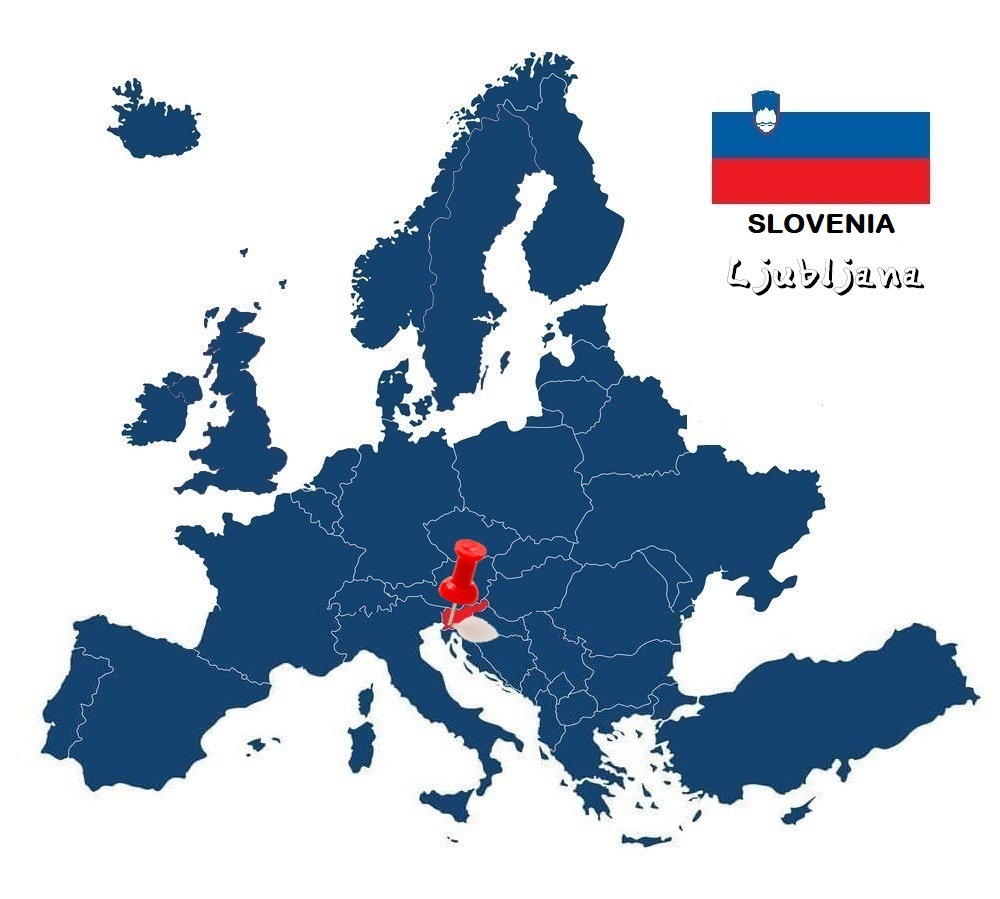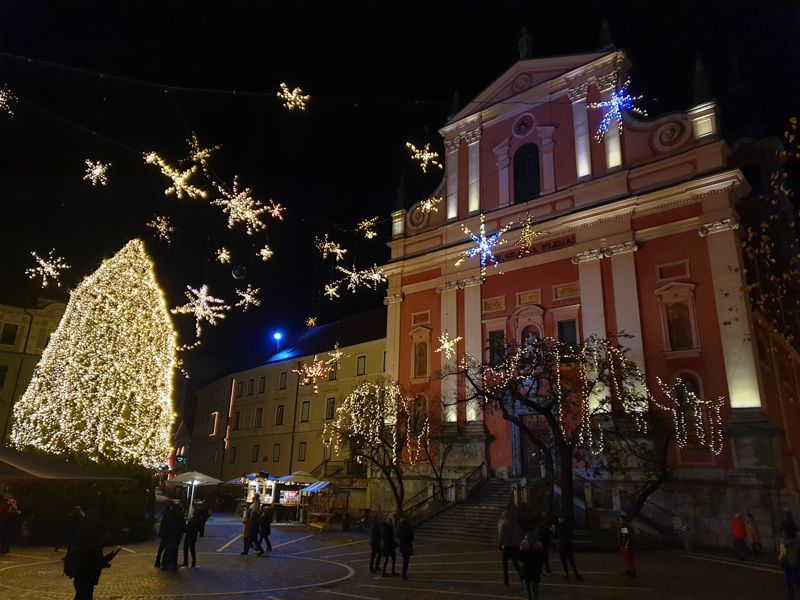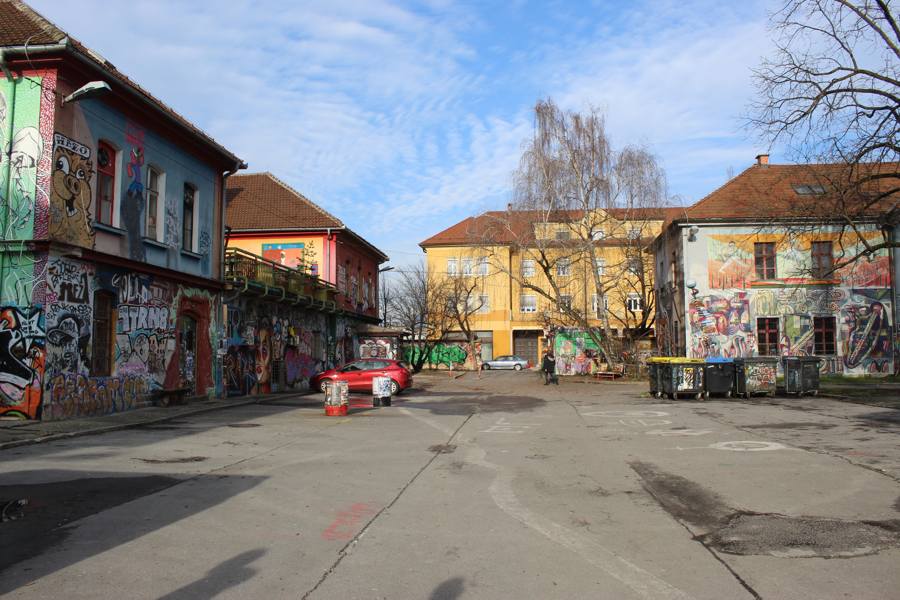
With one foot in the Balkans and the other in Central Europe, Ljubljana has plenty of natural beauties, artistic atmosphere, architectural diamonds and youthful pulse. Capital of a country that does not miss an opportunity to remind us that love is everything in life, something that exists in its name, "S-LOVE-NIA"!
A few words about the city
Ljubljana is the capital of Slovenia and the largest city in the country, with a population of 292,988 inhabitants inside and 361,134 in the wider area. It is located in the centre of Slovenia, making movements and trade very easy, while due to its geographical location it has received influences from Slavic, Latin and German culture. Its historic centre is kept intact and unaffected by modern architecture, so a stroll through the city centre takes you to another era. It is full of parks, lakes, as well as theatres, galleries, museums and music venues, since the arts have always played an important role in the city. So I will try to present Ljubljana through my own eyes and share with you what I think somebody should see, visiting the city for the first time.
Ljubljanski grad
Undoubtedly the Castle of Ljubljana (Ljubljanski Grad) is the most recognizable attraction in the city. It dominates in the top of a verdant hill, and its history seems to start in the 9th century, although the castle is first mentioned only in 1144. Its current image, however, comes after the earthquake of 1511 and further renovations in the 17th century. In the past it has served many uses, since it was the royal residence of the Habsburgs, provincial jail, and then properties of the Napoleonic army. For a panoramic view of the city from the tower - observatory of the castle, use the cable car or the tourist train that connects the old town and departing every hour from Stritarjeva Street, opposite the Town Hall. Admission to the castle is free, but if you want to enter any of the exhibitions hosted there you have to pay 10e.

Zmajski most
The Dragon Bridge (Zmajski most) is one of the most photographed spots in Ljubljana. It took its name from the four dragon statues, which are located at both ends, and the oxymoron is that in the original designs, it was supposed to be decorated with feathered lions instead of dragons. Constructed from 1900 to 1901, is a fine example of Art Nouveau architecture. This bridge replaced an old wooden one, which has existed in the same site since 1819, and when it was built it was one of the largest of its kind in Europe. Locals love to say that if you haven't been photographed in the shadow of dragons, you haven't visited Ljubljana.
Prešernov trg
Prešeren Square (Prešernov trg) is the main square of the city and the venue for the country's largest festivals, concerts, sports and political events. It is perhaps the only central square in the world which is decorated with a statue of a poet, rather than a civilian or military hero. I refer, of course, to the poet, France Prešeren (1800-1849), who wrote mostly in Slovenian and is best known for his sonnets, being one of Europe's great romantic poets. After the devastating earthquake of 1895, the square saw many of the historic buildings that adorned it to be destroyed, but after the gradual art nouveau renovation, which began in the first decade of the 21st century, many of these "reborn from their ashes.”
The Franciscan Church of the Annunciation (Franciskanska cerkev) is, of course, the jewel of the square. It is an impressive pink temple, built from 1646 to 1660 and at the beginning it was the residence of the Augustine monks. The facade of the church, completed around 1700, rebuilt in the 19th century and renovated in 1993, is adorned with a bronze statue of Our Lady, the largest statue of Madonna in Ljubljana. The interior of the church is decorated with frescoes by Matevž Langus in the mid-19th century, while the ceiling with murals by Matej Sternen. In a special chapel there is a cross designed by Jože Plečnik.

Tromostovje
The Triple Bridge (Tromostovje) is the second most famous of the city and is a unique architectural jewel. On the one hand it overlooks Prešeren square and on the other side in an alley overlooking the castle at the top of the hill. The central point of the pedestrian bridge was created in 1842, replacing an old wooden, while the other two sides were added later (1929-1932), again from the Jože Plecnik. On each of the two identical pedestrian bridges, there are stairs that lead to terraces, just above the Ljubljanica River, offering a magical view of Ljubljana.
Central Market
Between the Dragon Bridge and the triple bridge, the Central Market of Ljubljana is featured. This colorful market is also work of Joze Plecnik and is a first-class opportunity to grab the locals' pulse. There you will find local cheese and sausage (prosciutto prsut), spices, as well as special souvenirs such as handmade knitwear and ceramics. On Sunday's flea market, on the riverside pedestrian Cankarjevo nabrezje, you can find interesting collectibles, from vintage postcards to antiques, while on the weekend Art Market, which operates only during the summer months in the Breg area, you will find paintings, jewelry and pottery by local artists at good prices.
Katedrala Ljubljana
The Cathedral of Ljubljana (Katedrala Ljubljana) is located in the historic centre of the city and is dedicated to St. Nicholas. Its construction began in 1701 and was completed seven years later, while initially it was a gothic church. In the early 18th century it was replaced by a baroque building and much later took its present form. It is one of the city's landmarks and is easily recognizable due to the impressive green dome and the twin towers, located on the square Cyril and Methodius (Ciril-Metodov trg). The interior of the Cathedral is decorated mainly with frescoes by Giulio Quaglio and statues of Angelo Putti, while there are also spots that were painted by Matevž Langus. Entrance to the temple costs 2e.

Mestni Trg
The town square (Mestni Trg) is where some of the most important monuments of Ljubljana are located. First is, of course, the impressive Town Hall (Mestna hiša). It was built in the late 15th century by Peter Bezlaj and received its present appearance between 1717 and 1719. Its facade reflects Venetian architectural influences, while the vestibule is designed in a Gothic style. There you will also find a plaque with a coat of arms, surviving from the original Town Hall building and a 17th-century lion statue of Hercules, which was formerly part of the Hercules Fountain, which was located in the middle of the nearby Stari trg square.
In the town square there is also a copy of the Robba fountain (Robbov vodnjak). Created between 1743-1751 by the Venetian sculptor and architect Francesco Robba, who spent most of his life in Ljubljana and is considered the city's largest baroque teacher in sculpture. After completing this project, he remained firm and moved to Zagreb. The Robba Fountain was designed based on the famous Roman fountains and represents 3 Gods, believed to represent the rivers Sava, Ljubljanica and Krka. The original is in the National Gallery of Slovenia.
Finally, on the square you will find Krisper House, the house in which Prešeren was born in 1816 and the house of Gustav Mahler.
Park Tivoli
Park Tivoli is Ljubljana's largest and most beautiful park, extending right downtown. Designed in 1813 by the French engineer Jean Blanchard and created with the Association of parks surrounding, the Podturn and the Cekin Mansions. Tivoli covers an area of about five square kilometers and is crossed by three large walks full of chestnuts, lakes, fountains, statues, greenhouses and baroque mansions that house the National Museum of Contemporary History of Slovenia (Muzej Novejše Zgodovine Slovenije) and the International Centre for Graphic Arts. The area of the park is combined with a visit to the slopes of Rožnik Hill, which is famous for its hiking trails.
Metelkova
The Metelkova area is the most hipster spot in Ljubljana and an autonomous cultural zone, named after the nearby Metelko Street. It is an old barrack of the Yugoslav People's Army, which has been transformed into a cultural and artistic venue for alternative artists, full of graffiti, galleries, pioneering designers' studios and generally considered the "alternative" hangout of the city. Especially on the weekends, you will find plenty of atmospheric bars and clubs for all tastes, at very good prices.
The museums
The first museum worth a visit in Ljubljana is the National Museum of Slovenia (Narodni muzej Slovenije). Housed in a neo-renaissance palace of 1885, and there exhibited the greatest archaeological finds of the country. Among other things, you will be able to admire the oldest musical instrument in the world, a flute from the Neanderthal era, aged 60,000 years! The entrance costs 6e.
The National Gallery of Slovenia (Narodna Galerija) is the country's most important art gallery, possessing the largest collection of Slovenian paintings from the Middle Ages until the 20th century, as well as an extensive collection of works by renowned European painters. There you will also find the authentic Roba fountain, which I mentioned above. The entrance costs 7e.
Finally, it's worth a stroll through the Museum of Architecture and Design (Muzej za arhitekturo in oblikovanje), dedicated to Gaudi of Ljubljana, Joze Plecnik. Located in the castle Fužine, the only still-preserved renaissance castle of the city and is one of the oldest museums of this kind in Europe. Every year it organizes exhibitions and events in the field of architecture, urban planning, industrial and graphic design, as well as photography. The entrance costs 6e.
How to go
Unfortunately, there are no direct flights from Thessaloniki to Ljubljana, so your options are two. The first is to get to the city via an intermediate flight by air. The best choice comes from AirSerbia, i.e. a flight to Belgrade and then to Ljubljana (Jože Pučnik Airport), with proper planning can someone find tickets from 216€ round-trip. You can even fly to another nearby country, such as Croatia, Austria or Italy, and from there to reach the city by train or bus, since the distances are small and the prices low.
Where to stay
Ljubljana is a small city, and although it is beautiful, I wouldn't call it touristy, combined with the fact that Slovenia is an economic country; the choice of location should not be a concern. Most, if not all, of the city's attractions are centered on the old city, so it is a good idea to look around. My suggestion is Bed & Breakfast Atticus. These are beautiful and spacious rooms in the city center overlooking Ljubljana Castle, with good value for money.
How to move
Moving to Ljubljana is really easy, since the city centre is relatively small and ideal for walking, and there are places everywhere to rent bicycles if you wish. Due to its size there is no metro, but if you need local transportation, then you have to use city buses or taxis. Depending on the days you stay, it is worth to buy “Urbana”, an unlimited travel card.
What to eat
Ljubljana's cuisine is a blend of cultural influences from the Mediterranean, the Alps, the Pannonian Basin and the Balkans, with emphasis on local organic ingredients. At local family restaurants (gostilna) you will taste typical Slovenian specialties and delicacies such as Kranjska klobasa (spicy sausage), Kraški pršut (pork prosciutto), savory or sweet Štruklji (baked or boiled roll of dough stuffed with tarragon, cottage cheese and poppy seeds or walnuts, and apple), bograč, (goulash from Prekmurjea region), as well as famous desserts such as Prekmurska gibanica (sweet pie with poppy seeds, cottage cheese, walnuts and apple) and Potica (roll cake with various fillings such as cottage cheese, walnut honey). So to taste these local delicacies, I suggest visiting the Julija Restaurant, which has excellent cuisine in a beautiful area or the Sarajevo ’84, which although located in a basement, will win you over with its delicious flavors and its special decoration. I also suggest you try fine Slovenian vineyard wines in the center's modern vinotekas and not miss the chance to enjoy street-pleasing street food in various parts of the city, with favorite snack the burek (stuffed with cottage cheese, cabbage and sausage). If you are still a fan of falafel, then I suggest Abi Falafel, which is a breath away from the Dragon Bridge. Finally, for coffee and sweet I recommend Cacao, overlooking the river Ljubljanica.
Useful information

In Slovenia we travel with a passport or a new type of Police identity card, where the information is written in Latin characters.
In Ljubljana the language used is, of course, Slovenian. The majority, however (especially young people), speak English, so ask for clarification in English.
The currency of the country is the euro.
Ljubljana is an hour behind Greece (GMT +2).
The Greek Embassy in Ljubljana is located on 14 Trnovski Pristan, and its phone number is +3861 4201400.
Getting to and from Ljubljana Airport is easy, as there are regular buses (Alpetour) that will take you to Železniška postaja Ljubljana Central Train Station with 4.10e, in about 50 minutes.
As a central European city, it has cold winters and cool summers. Ideal time to visit Ljubljana is the end of spring to beginning of summer, but the rains usually don't miss even then. But because the whole country is green, the landscape will be just as impressive in the autumn, with the alternation of colors in the leaves of the trees.
Recommended excursions → Lake Bled, Maribor, Zagreb, Graz

If this article seemed interesting or contributed to your quality information, then you can like my facebook page: o_thessalonikios or follow me on instagram!
Mouzakidis Pantelis









